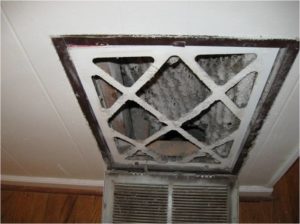Prevent Mold Illness by Following These 13 Tips
Reducing the risk of mold illnesses means you are reducing the risk of mold in the home. It is very unhealthy to live in the same space as mold. Here are some tips for reducing your risk to mold exposure.
- Use a dehumidifier, especially in the basement during the summer months. Mold tends to grow at 60% and above humidity, so keeping it under that will reduce the risk of mold growth.
- In the summer, also use an air conditioner to cut through the humidity. Make sure to clean and/or change the filters so dust does not accumulate inside the ducts and mechanical systems.
- No A/C? The use fans and open windows to improve air flow. Solid air flow prevents and/or limits mold growth.
 Keep your house clean. You may not realize it, but dust and grime build-up can lead to mold growth. How? Well, the dust and grimes act as soil for the mold to grow in. And then you add in the humidity or condensation as the moisture and you have a recipe for mold growth. So vacuum and dust weekly to remove these mold spores from the surface. By doing so, you will be preventing the mold from taking root and growing.
Keep your house clean. You may not realize it, but dust and grime build-up can lead to mold growth. How? Well, the dust and grimes act as soil for the mold to grow in. And then you add in the humidity or condensation as the moisture and you have a recipe for mold growth. So vacuum and dust weekly to remove these mold spores from the surface. By doing so, you will be preventing the mold from taking root and growing.- Keep the gutters clean and free flowing. Gutters help to divert water away from the foundation walls, thus limiting and potential mold growth in those areas.
- Turn on the fan in your bathroom to reduce moisture. Again, this increases the air flow, thus limiting the potential for mold growth.
- When you cook in the kitchen, use the ventilation. By doing so, you are limiting the potential for mold spores to spread.
- Do not ignore damp clothes. This might be self-explanatory, but do not leave wet clothes inside the washing machine for long stretches of a time. Mold can begin to grow on them. Once the load is complete, take the clothes out and put them in the dryer or hang them up.
- Promptly clean up any spills. No matter how minor. Mold growth can begin between 24 and 48 hours on wet surfaces. Carpets, floors, furniture, clothing, bedding, foundation walls, and basement floors are all common areas for mold growth. So do not neglect any spills. And definitely handle any flooding as soon as possible.
- Areas that are prone to getting wet should not have any carpets. We recommend replacing and basement or bathroom carpets with area rugs. These rugs can be cleaned promptly in case of flooding, spills, or other wetness happening. So you can remove, clean and dry an area rug pretty quickly in case of an emergency.
- For crawlspaces, there should be a vapor barrier over the dirt or have one installed under the cement floor. It is imperative to have crawlspaces be properly ventilated with the pipes insulated.
- Do not let leaks linger! Leaks are a major concern when it comes to moisture in the home. Leaks can come from pipes, appliances, the roof, and faucets. Please inspect your home regularly for any signs of leaks or water damage. Common places to check for leaks includes under the sink, around fridges, under the floor, around air conditioners and near toilets, tubs and showers.
- Check for a musty mildew type of odor. If you smell something along those lines, that is a sign for mold growth.
Contact NYIAQ with Mold Questions
For professional mold inspections, turn to NY Indoor Air Quality Solutions. Learn more about the importance of mold inspections and how getting one is a great way to reduce the risk of mold illness. We have years of experience helping people across Long Island with their mold problems. From Queens to the East End of Long Island (including Hampton Bays, West Hampton, South Hampton, East Hampton, Bridgehampton, Sag Harbor, Water Mill, Quogue and Amagansett), we have the expertise to prevent the growth of mold in your home. Keeping you and your family safe.
When you reach out to NYIAQ, we can provide you with a no-obligation consultation to go over whatever questions you have about mold. Schedule an inspection, too. And check out below for some more information about the prevention of mold growth and mold illness.
